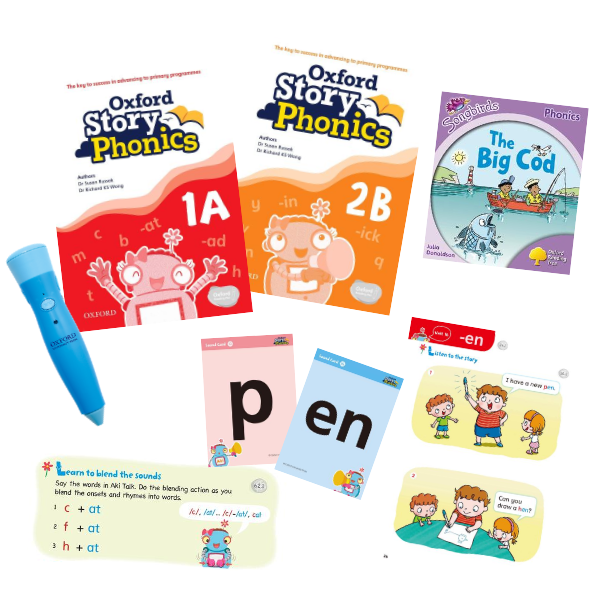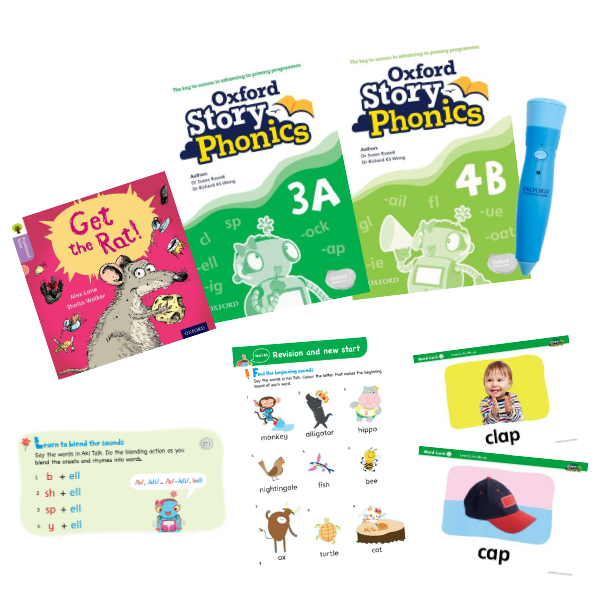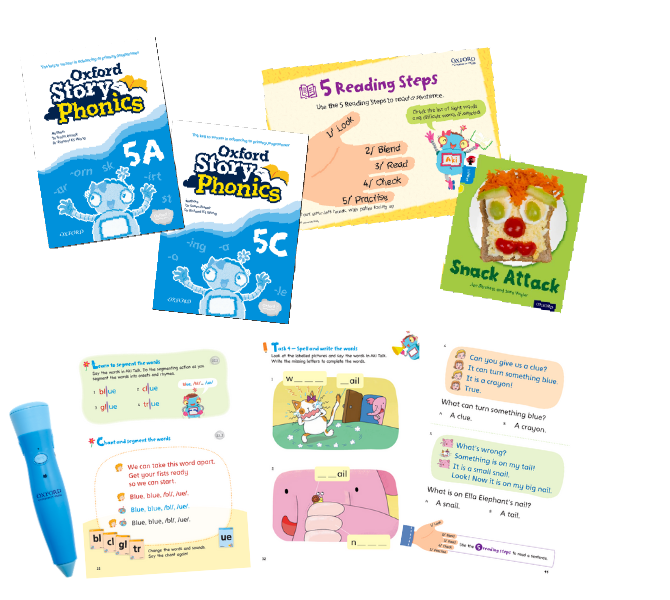Unique Oxford phonics teaching methodology – onset-rhyme approach

Based on ‘Oxford 5 Steps towards Successful Phonics Learning’, Oxford Story Phonics adopts the onset-rhyme approach to develop young children’s phonological awareness progressively. Through learning about syllables, onsets and rhymes, as well as acquiring blending and segmenting skills, children will be well prepared for reading and writing in the future with a solid foundation of oral English and phonics.
From our experts
Why do we adopt the onset-rhyme approach instead of the common CVC (Consonant-Vowel-Consonant) approach? What are the advantages of the onset-rhyme approach?

“English spelling can be tricky, especially regarding the sound-letter correspondences. For example, the letter ‘a’ is pronounced differently in the words ‘cat’ (/æ/), ‘car’ (/ɑː/) and ‘call’ (ɔː). If young learners blend the phonemes using the CVC approach (i.e. c-a-t, c-a-r, c-a-ll), they may be easily confused as the pronunciation of the vowel may vary from word to word.
However, if we look at the vowel letter and the following letter(s) as a single unit called ‘rhyme’ (e.g. ‘at’ in c-at), the pronunciation of the vowel becomes more stable. When children understand the concepts of onset and rhyme, they will be able to apply their knowledge of the rhyme families to reading both familiar and unfamiliar words in texts. For example, after learning the rhyme ‘an’ as well as the words ‘man’, ‘van’ and ‘fan’, children will also be able to read new words such as ‘can’ and ‘pan’. This guarantees promising learning outcomes and helps children build their confidence in learning.”

-- Dr. Susan Russak (Head of English department, School of Education, Beit Berl Academic College, Israel) and
Dr. Richard Wong (Adjunct Assistant Professor, Department of Linguistics and Modern Languages, The Chinese University of Hong Kong)
Four reasons to choose Oxford Story Phonics
Right level for your child
How can I choose an appropriate phonics programme for my child?
- Based on ‘Oxford 5 Steps towards Successful Phonics Learning’, Oxford Story Phonics adopts the simple and effective onset-rhyme approach, fosters the phonological awareness of children and consolidates their foundation of phonics learning.
- Designed by the authors and Oxford University Press editors of the ELTons award-winning phonics series, theory and practice go hand in hand in this programme, with guaranteed course quality and contents which perfectly fit children’s learning needs under the local educational system.
- The programme is ability-oriented. Every child’s language level will be assessed in advance before they are put into appropriate class.
Flexible blended learning
What should I do during the suspension of face-to-face classes at the learning centre?
- The 3-in-1 blended learning including ‘face-to-face class’, ‘online class’ and ‘home learning’ ensures teaching flexibility and learning effectiveness.
- The blended learning materials support both online and offline (face-to-face) teaching, enhancing children’s learning motivation and ensuring learning outcomes.
- The learning resources are compatible with Oxford Reading Pen for revision, recording and interactive activities at home.
Advancing to primary programmes
How can my child transit smoothly from kindergarten to primary school despite the distinct ways and objectives of learning?
- The unique and easy-to-follow ‘5 Reading Steps’ and ‘5 Writing Steps’ enable children to read and write sentences independently, helping them become independent learners.
- The diversified reading and writing activities, such as reading comprehension, dictation exercises, fill in the blanks and sentence construction, are in line with Hong Kong primary curriculum, getting children ready for primary school.
- Children can learn in meaningful contexts through the stories as well as appropriate reading and writing activities. Progressing from reading to writing enhances children’s reading and writing skills simultaneously, ensuring a smooth transition to primary English learning.
Fun and effective learning
What can be done to arouse children’s interest in phonics learning and ensure learning outcomes?
- Introducing readers of the worldwide bestselling Oxford Reading Tree into the programme, the input of story elements makes lessons captivating and distinctive.
- It is easy to create a language-rich environment with the stories, chants and games in the programme, fulfilling children’s cognitive developmental needs and enhancing learning outcomes.
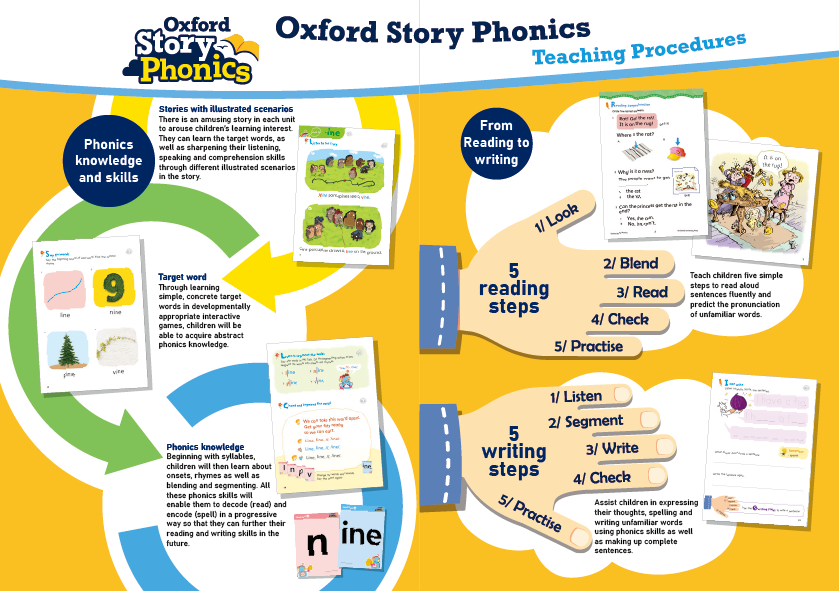


Programme Design and Learning Outcomes
Consisting of three stages with a total of six levels, the programme is suitable for children aged 3 and above. A minimum of three years is recommended to complete the programme.
Foundation Year 1 (Levels 1-2)
Year 1 focuses on developing phonological awareness, fundamental phonics skills (e.g. syllables, onsets, rhymes) and early literacy skills.
Programme Structure
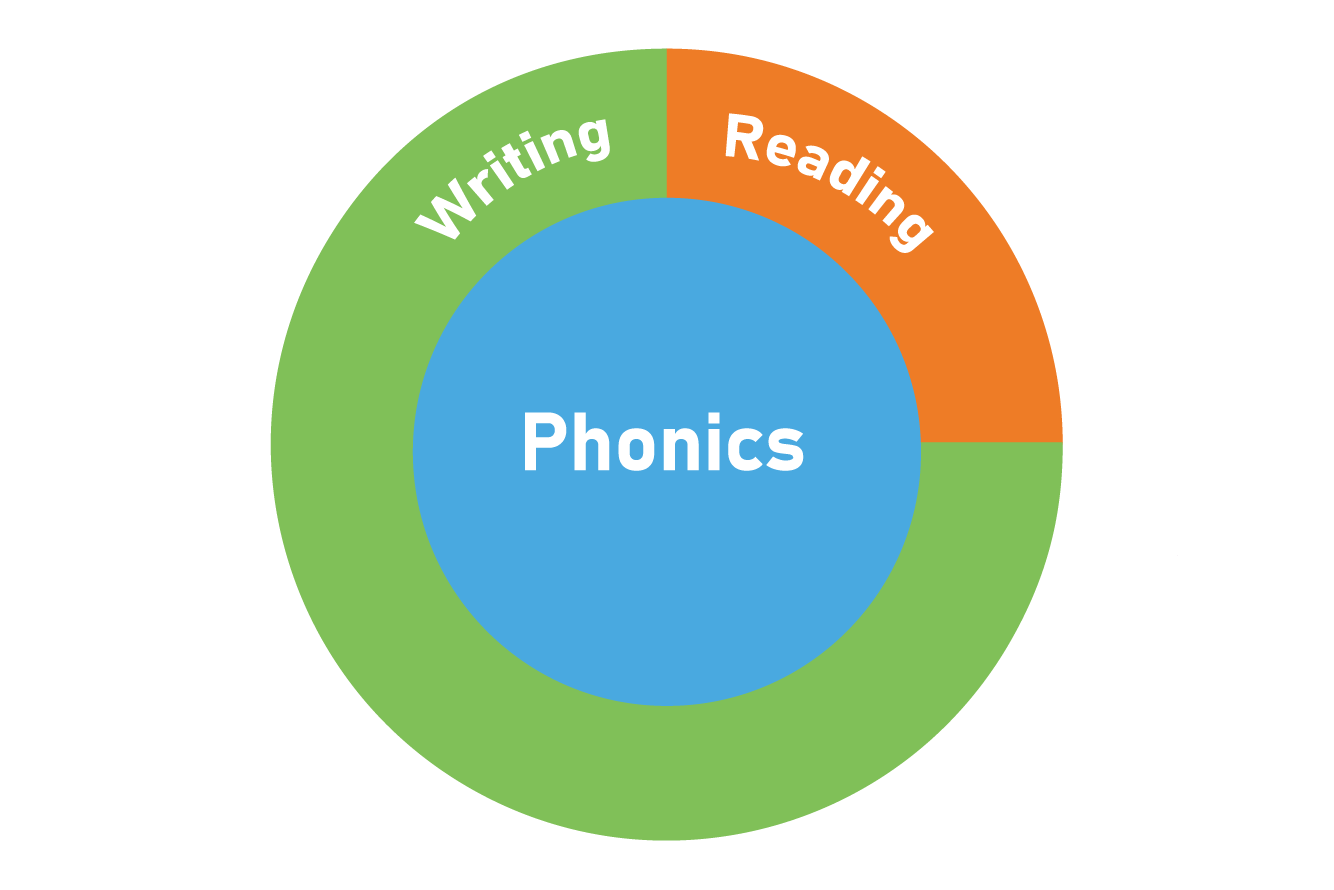
Learning materials
Learning outcomes
• Able to count the syllables
• Able to say the 26 letter names and letter sounds
• Able to say 11 rhyme families and the corresponding target words
• Able to blend onsets and common rhymes to form monosyllabic words
Reading and writing
• Able to develop print awareness
• Develop eye-hand coordination and fine motor skills
• Able to write capital and small letters as part of a word
• Able to read aloud simple sentences and nursery rhymes
• Read 37 stories and finish reading Read with Oxford Stage 1 readers with guidance
Foundation Year 2 (Levels 3-4)
Year 2 reinforces children’s blending and segmenting skills, and introduces a systematic approach to reading and writing.
Programme structure
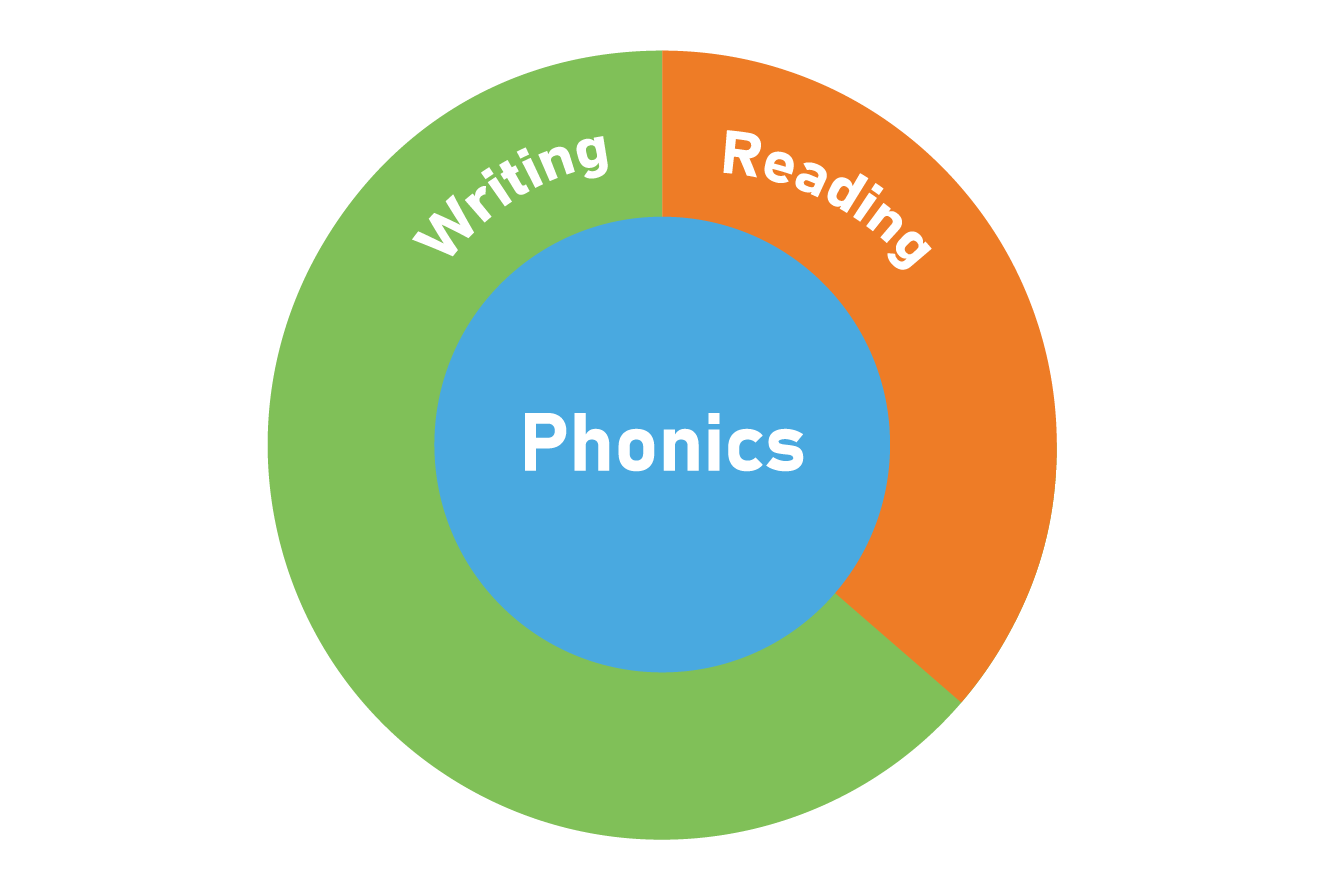
Learning materials
Learning outcomes
• Able to say 20 digraphs, consonant clusters and corresponding target words
• Able to say 24 rhyme families and the corresponding target words
• Able to apply blending and segmenting skills to monosyllabic words
Reading and writing
• Able to spell simple words
• Able to recognize some common sight words
• Able to read and write simple sentences using the ‘5 reading steps’ and ‘5 writing steps’
• Able to answer simple comprehension questions
• Able to complete funny poems using the target rhymes
• Read 24 stories and finish reading Read with Oxford Stages 1-3 readers with guidance
Enrichment Year 3 (Levels 5-6)
Year 3 encompasses more advanced phonics knowledge and skills, and further develops literacy skills for a smooth transition to primary English learning.
Programme structure
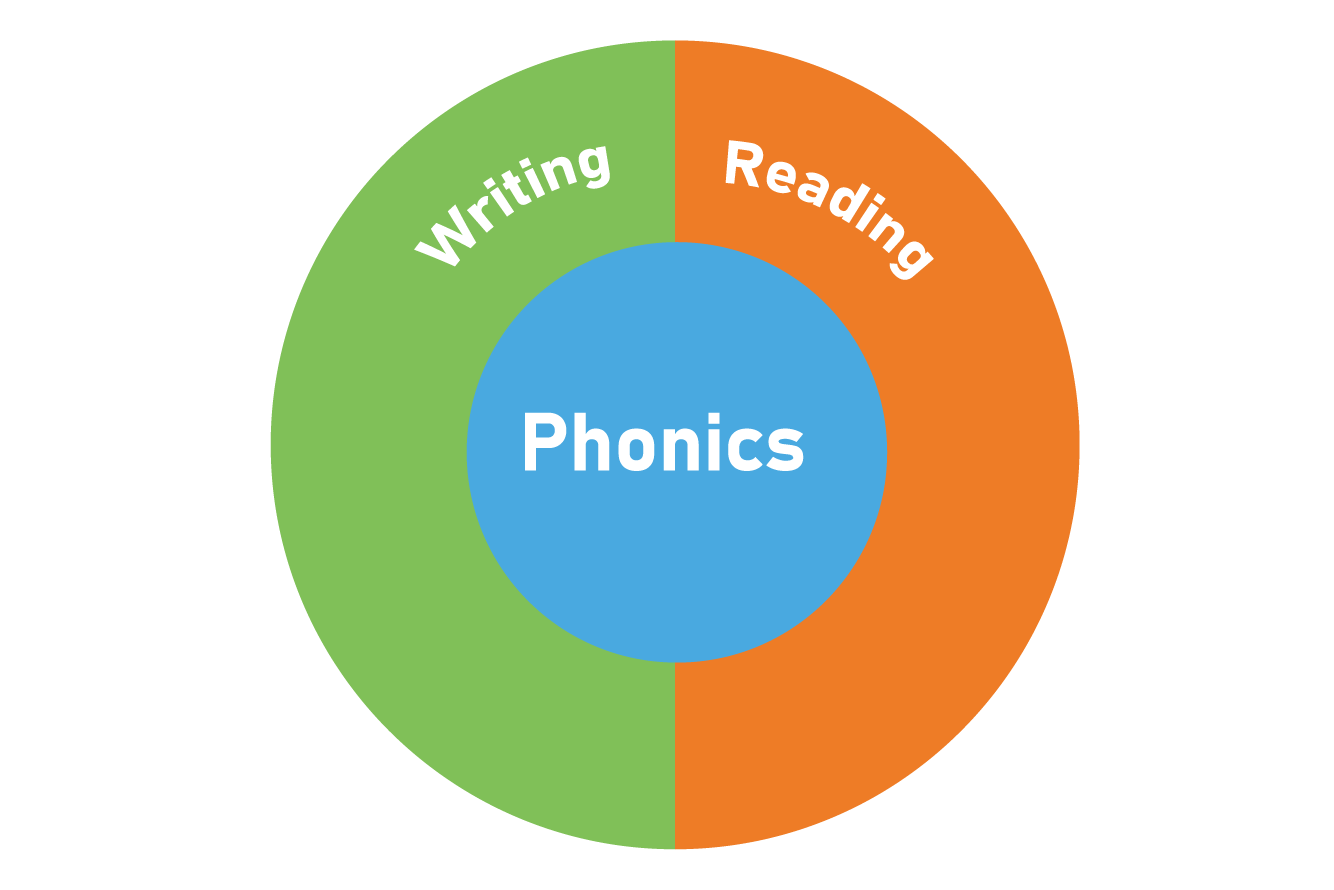
Learning materials
Learning outcomes
• Able to further apply blending and segmenting skills
• Able to use more phonics rules to decoding unfamiliar words and disyllabic words
Reading and writing
• Able to read an array of text types and Read with Oxford Stages 2-4 readers (fiction and non-fiction)
• Able to use reading comprehension strategies, e.g. 5W1H and mind map
• Able to complete guided writing tasks
• Able to grasp basic grammatical rules


